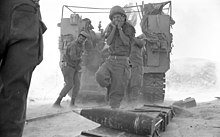Pop trauma
A bang trauma is when the effect of a very high sound pressure on the ear leads to damage to the inner ear . This is the case when the damaging sound only has a very short effect (1 to 3 ms). Prolonged exposure to very high sound pressure leads primarily to damage to the eardrum and ossicles . The bang trauma is part of the acoustic trauma .
In addition to the damage caused by the pop trauma, an explosion trauma can also damage the inner ear. In otology , a distinction is made between pop trauma and explosion trauma based on the consequences of the sound and not the physical properties of the sound. Many former miners suffer from blast trauma.
causes
Any brief sound event that exceeds a certain sound pressure level can cause a blast trauma. Examples are pistol or rifle shots, alarm guns , firecrackers , airbags , explosions, blows to the ear , slamming doors, bursting tires and nearby lightning strikes . The level of low frequencies transmitted into the inner ear is limited by the maximum deflection of the eardrum and overdrive occurs. The overdrive creates new frequencies 1) Hearing is damaged in the area of the newly created high frequencies.
The very high frequencies 2) of scare devices (marten fright, cat fright, fox fright, etc.) cause irreversible inner ear injuries when the device is switched on if the distance is insufficient. At high frequencies, inertia prevents the ossicles and eardrum from deflecting into a critical area. The ossicles and eardrum are never damaged, even after minutes of exposure to sound.
1) The movement of the eardrum is synchronous with the audio signal. This is why the behavior is physically identical, regardless of whether the overload occurs in the audio signal, the speaker membrane or the eardrum.
2) Provided the amplitude is constant, the load in the inner ear increases to the third power of the frequency.
Symptoms
- Clogged ear feeling
- Hearing loss
- Tinnitus
- Possibly short, sharp pain
- Hyperacusis ( sensitivity to noise)
- Dizziness or imbalance
The auditory canal and eardrum are not affected, the blast trauma only affects the inner ear. In the tone audiogram , one finds a mostly asymmetrical sensorineural hearing loss in the form of a depression in the hearing threshold curve in the high frequency range. As a rule, hearing improves again in the first hours and days after the event, but often the hearing impairment persists.
Therapy and prognosis
As in the case of a sudden hearing loss , a hemo- rheological infusion therapy with HAES ( hydroxyethyl starch ) and procaine is used as the first measure . Cortisone can also be used. If both treatment methods fail, hyperbaric oxygen therapy is appropriate. In any case, an early start of therapy is indicated for a favorable prognosis. The earlier therapy is started, the lower the risk of permanent damage. Surgical intervention is only necessary if one or both windows of the inner ear are damaged or a perilymic pistula has formed.
The prognosis of a pop trauma is generally very good. Improvement usually occurs within six weeks of the event, often until complete recovery. Poor prognoses and mostly not treatable are complaints that persist after the six weeks.
See also
Individual evidence
- ↑ Friedrich Pfander: Das Bang trauma - analysis, prevention, diagnosis, treatment, prognosis and assessment , p. 1
- ↑ " Bang trauma from marten fright devices " Sauf knalltrauma.ch
literature
- Friedrich Pfander: The bang trauma - analysis, prevention, diagnosis, treatment, prognosis and assessment , Springer-Verlag, 1975, ISBN 978-3-642-86061-4
Web links
- "Das Knalltrauma" Collection of documents on knalltrauma.ch
